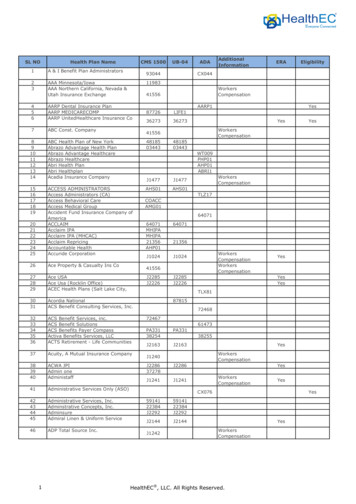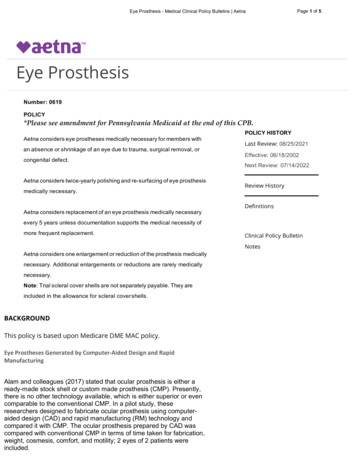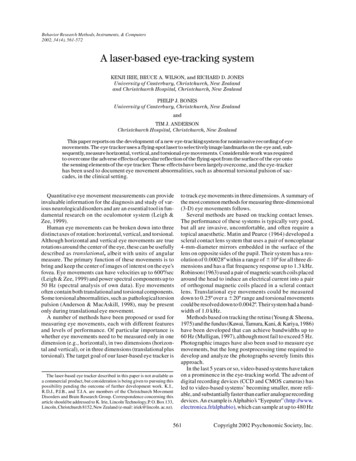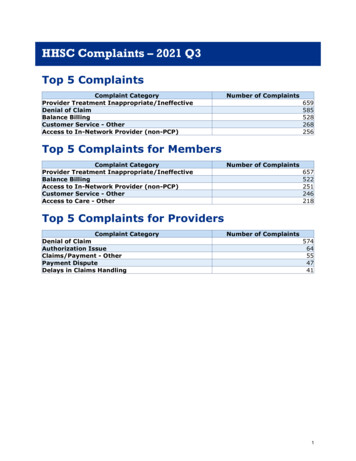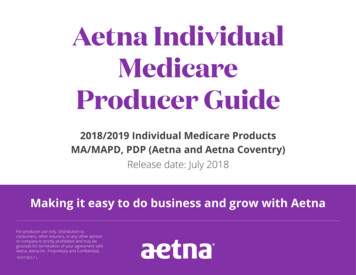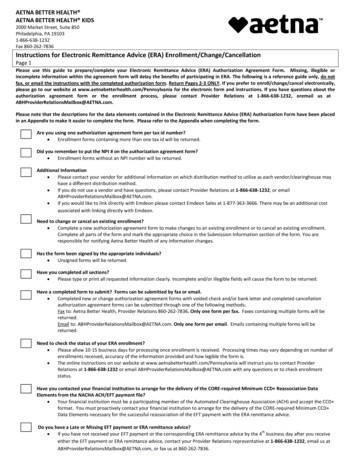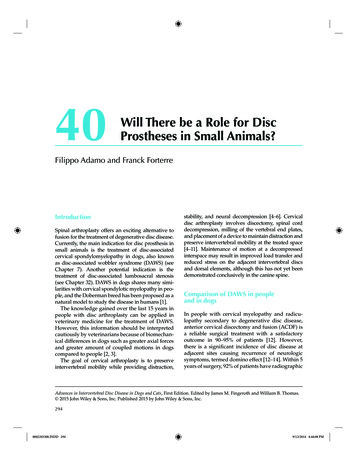
Transcription
Page 1 of 5(https://www.aetna.com/)Eye ProsthesisClinical Policy BulletinsMedical Clinical Policy BulletinsNumber: 0619Policy*Please see amendment for Pennsylvania Medicaidat the end of this CPB.Aetna considers eye prostheses medically necessary for members with an absenceor shrinkage of an eye due to trauma, surgical removal, or congenital defect.Aetna considers twice-yearly polishing and re-surfacing of eye prosthesis medicallynecessary.Aetna considers replacement of an eye prosthesis medically necessary every 5years unless documentation supports the medical necessity of more frequentreplacement.Aetna considers one enlargement or reduction of the prosthesis medicallynecessary. Additional enlargements or reductions are rarely medically ve: 06/18/200Next Review:06/27/2019Review HistoryDefinitionsAdditionalInformationNote: Trial scleral cover shells are not separately payable. They are included in theallowance for scleral cover shells.BackgroundThis policy is based upon Medicare DME MAC policy.http://www.aetna.com/cpb/medical/data/600 699/0619.html09/24/2019
Page 2 of 5Eye Prostheses Generated by Computer-Aided Design and RapidManufacturingAlam and colleagues (2017) stated that ocular prosthesis is either a ready-madestock shell or custom made prosthesis (CMP). Presently, there is no othertechnology available, which is either superior or even comparable to theconventional CMP. In a pilot study, these researchers designed to fabricate ocularprosthesis using computer-aided design (CAD) and rapid manufacturing (RM)technology and compared it with CMP. The ocular prosthesis prepared by CADwas compared with conventional CMP in terms of time taken for fabrication, weight,cosmesis, comfort, and motility; 2 eyes of 2 patients were included. Computerizedtomography scan of wax model of socket was converted into 3-D format using theMaterialize Interactive Medical Image Control System (MIMICS) software andfurther refined. This was given as an input to rapid manufacturing machine (Polyjet 3 D printer). The final painting on prototype was done by an ocularist. The averageeffective time needed for fabrication of CAD prosthesis was 2.5 hours; and weighed2.9 g. The same for CMP were 10 hours; and 4.4 g; CAD prosthesis was morecomfortable for both the patients. The authors concluded that the findings of thisstudy demonstrated the first ever attempt of fabricating a complete ocular prosthesisusing CAD and rapid manufacturing and comparing it with conventional CMP. Theyreported that this prosthesis took lesser time for fabrication, and was morecomfortable. They stated that studies with larger sample size are needed to furthervalidate this technique.CPT Codes / HCPCS Codes / ICD-10 CodesInformation in the [brackets] below has been added for clarificationpurposes. Codes requiring a 7th character are represented by " ":CPT codes covered if selection criteria are met:HCPCS codes covered if selection criteria are cpb/medical/data/600 699/0619.html09/24/2019
Page 3 of 5V2629HCPCS codes not covered for indications listed in the CPB:V2627ICD-10 codes covered if selection criteria are met:Q11.1S05.92x Z90.01The above policy is based on the following references:1. NHIC, Corp. Eye prosthesis. Local Coverage Determination L11529. DurableMedical Equipment Medicare Administrative Contractor (DME MAC)Jurisdiction A. Hingham, MA; NHIC; revised October 31, 2014.2. NHIC, Corp. Eye prosthesis. Local Coverage Article A33613. Durable MedicalEquipment Medicare Administrative Contractor (DME MAC) Jurisdiction A.Hingham, MA: NHIC; revised April 1, 2013.3. Vincent AL, Webb MC, Gallie BL, et al. Prosthetic conformers: A step towardsimproved rehabilitation of enucleated children. Clin Experiment Ophthalmol.2002;30(1):58-59.4. Custer PL, Kennedy RH, Woog JJ, et al. Orbital implants in enucleationsurgery: A report by the American Academy of Ophthalmology.Ophthalmology. 2003;110(10):2054-2061.5. Chin K, Margolin CB, Finger PT. Early ocular prosthesis insertion improvesquality of life after enucleation. Optometry. 2006;77(2):71-75.6. Song JS, Oh J, Baek SH. A survey of satisfaction in anophthalmic patientswearing ocular prosthesis. Graefes Arch Clin Exp Ophthalmol. 2006;244(3):330-335.7. Mattos BS, Montagna MC, Fernandes Cda S, Saboia AC. The pediatricpatient at a maxillofacial service: Eye prosthesis. Braz Oral Res. 2006;20(3):247-251.8. Alam S, Sugavaneswaran M, Arumaikkannu G, Mukherjee B. An innovativemethod of ocular prosthesis fabrication by bio-CAD and rapid 3-D printingtechnology: A pilot study. Orbit. l/data/600 699/0619.html09/24/2019
Page 4 of 5Copyright Aetna Inc. All rights reserved. Clinical Policy Bulletins are developed by Aetna to assist in administering planbenefits and constitute neither offers of coverage nor medical advice. This Clinical Policy Bulletin contains only a partial,general description of plan or program benefits and does not constitute a contract. Aetna does not provide health careservices and, therefore, cannot guarantee any results or outcomes. Participating providers are independent contractors inprivate practice and are neither employees nor agents of Aetna or its affiliates. Treating providers are solely responsiblefor medical advice and treatment of members. This Clinical Policy Bulletin may be updated and therefore is subject tochange.Copyright 2001-2019 Aetna Inc.http://www.aetna.com/cpb/medical/data/600 699/0619.html09/24/2019
AETNA BETTER HEALTH OF PENNSYLVANIAAmendment toAetna Clinical Policy Bulletin Number: 0619 Eye ProsthesisThere are no amendments for ual 10/01/2019
HCPCS codes not covered for indications listed in the CPB: V2627 . ICD-10 codes covered if selection criteria are met: Q11.1 S05.92x Z90.01. Page 3 of 5 . The above policy is based on the following references: 1. NHIC, Corp. Eye prosthesis. Local Coverage Determination L11529. Durable Medical Equipment Medicare Administrative Contractor (DME MAC)
